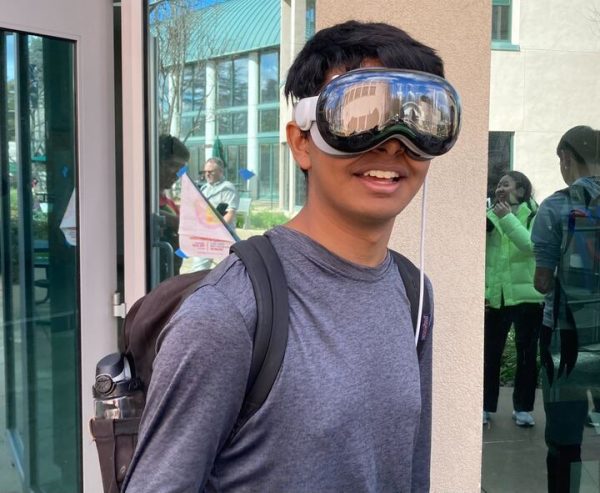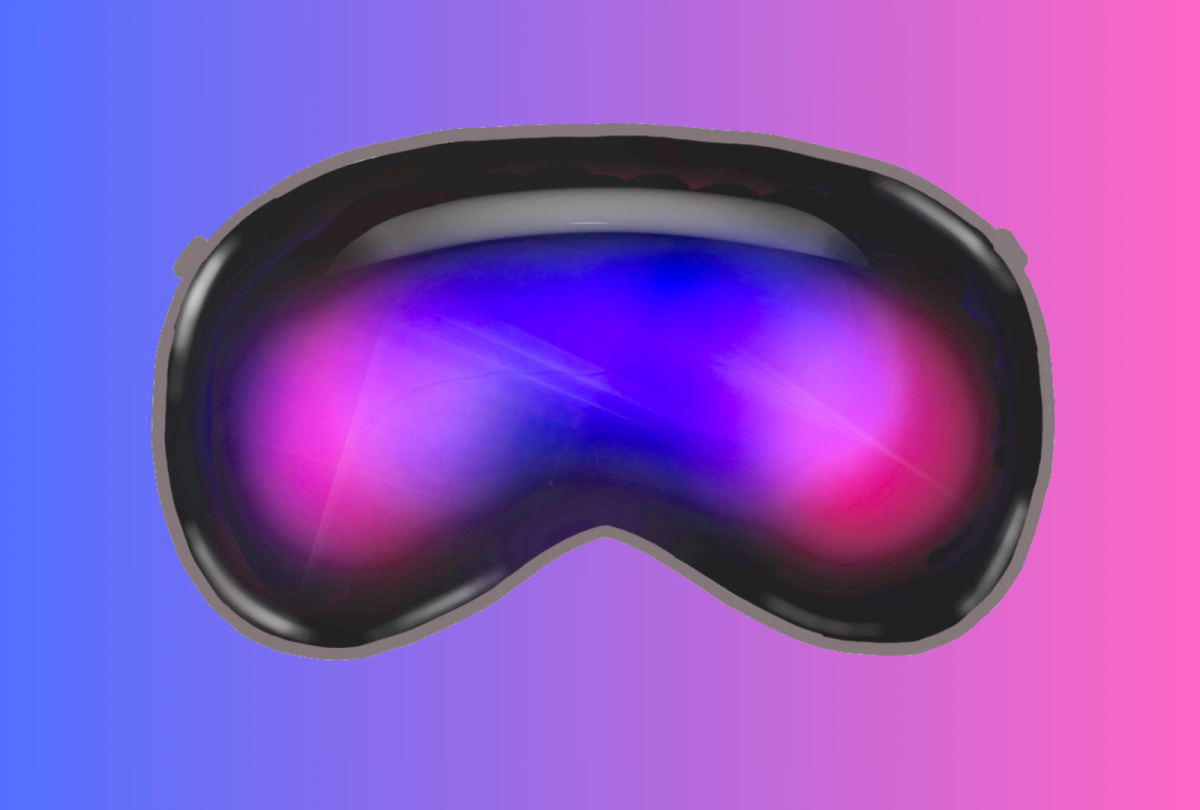Apple’s newest virtual reality headset, the Vision Pro, released in all Apple stores on Feb. 2. Priced at $3,499, the headset projects a stylistic digital screen right in front of users, allowing them to read the news, run applications and watch movies all in a 3D space.
What makes the Vision Pro especially cutting-edge is its unique method of handling displays. While traditional VR headsets contain physical screens within each lens, the Vision Pro casts high-resolution displays directly into the eyes. Additionally, Apple’s newest headset does not require handheld controllers or wearable sensors; users can navigate the digital landscape through eye movements or basic gestures.
As a consumer tech enthusiast, senior Kabir Ramzan is optimistic about the Apple Vision Pro, having recently placed a pre-order for it. He comments on Apple’s new product.
“It’s the next step in terms of human computer interaction,” Kabir said. “We’ve kind of maximized what we can do directly on a phone or on the computer, so it just feels like the next natural step to put it directly up in front of your face or in your eyes directly.”
One of the Vision Pro’s most prominent and impressive features is its ability to project 3D objects anywhere, with realistic spatial properties. It accomplishes this by placing a 2D display in the location of the object and tracking head, hand and eye movements. Every time the user’s head moves, the display moves in the opposite direction, creating the illusion of the object remaining stationary. Furthermore, the headset’s built in Light Detection and Ranging (LiDAR) scanner and TrueDepth camera work in conjunction to accurately maintain the shape and depth of the 3D object.
This technology has opened the doors to numerous possibilities, such as a more immersive metaverse experience. The advances Apple has made in micro-OLED displays mean that the Vision Pro is uniquely positioned to excel for both work and entertainment. Its ability to handle multiple applications simultaneously, while also allowing the user to view their surroundings, suggests that it has the potential to become a powerful tool for productivity. Additionally, its remarkable brightness and color reproduction will allow it to totally transform the nature of content consumption. Upper school computer science teacher Anu Datar shares her perspective on the product.

“People have said that it’s very comfortable and quite easy to use,” she said. “There are issues obviously, but I feel very hopeful that at some point in time, this will be something that will help a lot of people who have various disabilities to do things with a lot of ease. Maybe, at some point, people will not need to travel to experience going to a wildlife safari in Africa or for those who aren’t able to go due to physical limitations or financial issues, they’ll be able to experience things as well.”
Despite its myriad of features, Apple’s Vision Pro doesn’t exist without competitors. LG Electronics, a South Korean conglomerate, recently confirmed the development of an upcoming extended reality (XR) headset. Although not officially announced, news reports suggest that the company also plans to partner with Meta to work on a successor to Meta’s Quest Pro, which will directly compete with Apple in the VR headset market.
Sophomore Evan Zhang points out that Apple’s headset is intended for a totally different customer segment than other devices. Many other companies have focused on virtual reality’s applications in gaming, but Apple’s features are geared towards enhancing productivity instead.
“I don’t think it competes with other headsets because it’s geared completely towards office work,” Evan said. “Whereas all the other ones like the Meta Quest are more gaming oriented; you navigate the whole thing with your controllers.”
Despite the innovation it represents, the Vision Pro and future headsets also pose ethical concessions. With its incredibly immersive and thrilling experiences, VR holds the potential to hook users and promote addictions, as people divert their attention from the world around them to a virtual metaverse. Social media has already become an increasingly addicting experience, and combining it with augmented reality may worsen the problem. Additionally, there have already been reports of people being harassed and worse in the metaverse, which suggests that significant regulations and legislation are needed before this technology can truly be integrated into all aspects of society.
Regardless, Apple’s innovative headset still represents a meaningful step forward in the world of immersive devices. With developments in human technology accelerating at a rapid rate, it’s unclear what the future holds for virtual reality. Perhaps one day, other sensory elements such as touch, smell and taste may make their way into the metaverse, alongside sight and sound. But even if that doesn’t happen, we’ll still have the Vision Pro.


















![“[Building nerf blasters] became this outlet of creativity for me that hasn't been matched by anything else. The process [of] making a build complete to your desire is such a painstakingly difficult process, but I've had to learn from [the skills needed from] soldering to proper painting. There's so many different options for everything, if you think about it, it exists. The best part is [that] if it doesn't exist, you can build it yourself," Ishaan Parate said.](https://harkeraquila.com/wp-content/uploads/2022/08/DSC_8149-900x604.jpg)




![“When I came into high school, I was ready to be a follower. But DECA was a game changer for me. It helped me overcome my fear of public speaking, and it's played such a major role in who I've become today. To be able to successfully lead a chapter of 150 students, an officer team and be one of the upperclassmen I once really admired is something I'm [really] proud of,” Anvitha Tummala ('21) said.](https://harkeraquila.com/wp-content/uploads/2021/07/Screen-Shot-2021-07-25-at-9.50.05-AM-900x594.png)







![“I think getting up in the morning and having a sense of purpose [is exciting]. I think without a certain amount of drive, life is kind of obsolete and mundane, and I think having that every single day is what makes each day unique and kind of makes life exciting,” Neymika Jain (12) said.](https://harkeraquila.com/wp-content/uploads/2017/06/Screen-Shot-2017-06-03-at-4.54.16-PM.png)








![“My slogan is ‘slow feet, don’t eat, and I’m hungry.’ You need to run fast to get where you are–you aren't going to get those championships if you aren't fast,” Angel Cervantes (12) said. “I want to do well in school on my tests and in track and win championships for my team. I live by that, [and] I can do that anywhere: in the classroom or on the field.”](https://harkeraquila.com/wp-content/uploads/2018/06/DSC5146-900x601.jpg)
![“[Volleyball has] taught me how to fall correctly, and another thing it taught is that you don’t have to be the best at something to be good at it. If you just hit the ball in a smart way, then it still scores points and you’re good at it. You could be a background player and still make a much bigger impact on the team than you would think,” Anya Gert (’20) said.](https://harkeraquila.com/wp-content/uploads/2020/06/AnnaGert_JinTuan_HoHPhotoEdited-600x900.jpeg)

![“I'm not nearly there yet, but [my confidence has] definitely been getting better since I was pretty shy and timid coming into Harker my freshman year. I know that there's a lot of people that are really confident in what they do, and I really admire them. Everyone's so driven and that has really pushed me to kind of try to find my own place in high school and be more confident,” Alyssa Huang (’20) said.](https://harkeraquila.com/wp-content/uploads/2020/06/AlyssaHuang_EmilyChen_HoHPhoto-900x749.jpeg)












